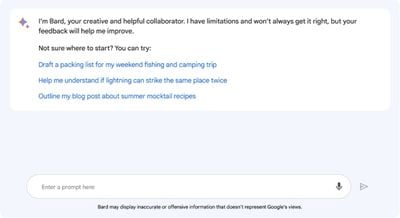Google today began allowing users to sign up to use Bard, its AI-powered chatbot that rivals Microsoft's Bing chatbot. First announced back in February, Bard is an experimental conversational AI service for Google Search.

Those interested in Bard can join Google's waitlist to get access, and some users have reported getting invitation emails just hours after signing up. There is a long list of sample functions that Google says Bard can perform:
- Explain why lightning might strike in the same place twice
- Help you write your first novel
- Draft a packing list for your weekend trip
- Outline a blog post about your summer mocktail recipes
- Explain why large language models might make mistakes
- Generate an art studio tagline
- Suggest high-protein options to add to a vegan diet
Bard beta access is limited to the United States and the UK at the current time, and there is an unknown wait time. Google does not allow Google Workspace accounts to request an invitation.
According to Google, Bard is using a "lightweight and optimized version of LaMDA," so the chatbot will offer a different experience than the OpenAI-powered Bing chat interface.
Bard is not designed to replace Google Search, and Google instead says it is "complementary." Google warns that Bard learns from a wide range of information that includes real-world biases and stereotypes, so the chatbot can provide inaccurate, misleading, or false information. It will improve over time based on feedback, and Google plans to add capabilities like coding and more languages in the future.
Comments
Post a Comment